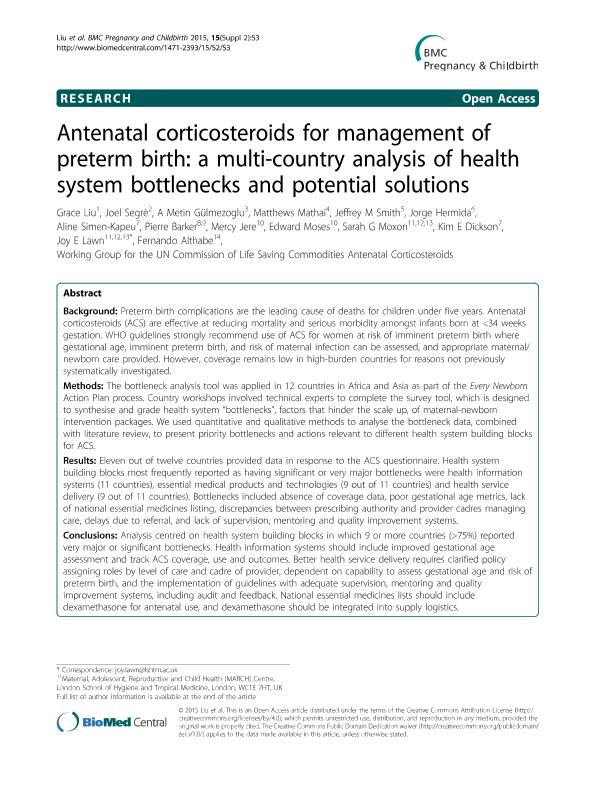Mostrar el registro sencillo del ítem
dc.contributor.author
Liu, Grace
dc.contributor.author
Segrè, Joel
dc.contributor.author
Gülmezoglu, A Metin
dc.contributor.author
Mathai, Matthews
dc.contributor.author
Smith, Jeffrey M
dc.contributor.author
Hermida, Jorge
dc.contributor.author
Simen Kapeu, Aline
dc.contributor.author
Barker, Pierre
dc.contributor.author
Jere, Mercy
dc.contributor.author
Moses, Edward
dc.contributor.author
Moxon, Sarah G.
dc.contributor.author
Dickson, Kim E.
dc.contributor.author
Lawn, Joy E.
dc.contributor.author
Althabe, Fernando

dc.date.available
2018-06-05T20:38:03Z
dc.date.issued
2015-09
dc.identifier.citation
Liu, Grace; Segrè, Joel; Gülmezoglu, A Metin; Mathai, Matthews; Smith, Jeffrey M; et al.; Antenatal corticosteroids for management of preterm birth: a multi-country analysis of health system bottlenecks and potential solutions; BioMed Central; BMC Pregnancy and Childbirth; 15; S2; 9-2015; 1-16
dc.identifier.issn
1741-7015
dc.identifier.uri
http://hdl.handle.net/11336/47397
dc.description.abstract
BACKGROUND:Preterm birth complications are the leading cause of deaths for children under five years. Antenatal corticosteroids (ACS) are effective at reducing mortality and serious morbidity amongst infants born at <34 weeks gestation. WHO guidelines strongly recommend use of ACS for women at risk of imminent preterm birth where gestational age, imminent preterm birth, and risk of maternal infection can be assessed, and appropriate maternal/newborn care provided. However, coverage remains low in high-burden countries for reasons not previously systematically investigated.METHODS:The bottleneck analysis tool was applied in 12 countries in Africa and Asia as part of the Every Newborn Action Plan process. Country workshops involved technical experts to complete the survey tool, which is designed to synthesise and grade health system "bottlenecks", factors that hinder the scale up, of maternal-newborn intervention packages. We used quantitative and qualitative methods to analyse the bottleneck data, combined with literature review, to present priority bottlenecks and actions relevant to different health system building blocks for ACS.RESULTS:Eleven out of twelve countries provided data in response to the ACS questionnaire. Health system building blocks most frequently reported as having significant or very major bottlenecks were health information systems (11 countries), essential medical products and technologies (9 out of 11 countries) and health service delivery (9 out of 11 countries). Bottlenecks included absence of coverage data, poor gestational age metrics, lack of national essential medicines listing, discrepancies between prescribing authority and provider cadres managing care, delays due to referral, and lack of supervision, mentoring and quality improvement systems.CONCLUSIONS:Analysis centred on health system building blocks in which 9 or more countries (>75%) reported very major or significant bottlenecks. Health information systems should include improved gestational age assessment and track ACS coverage, use and outcomes. Better health service delivery requires clarified policy assigning roles by level of care and cadre of provider, dependent on capability to assess gestational age and risk of preterm birth, and the implementation of guidelines with adequate supervision, mentoring and quality improvement systems, including audit and feedback. National essential medicines lists should include dexamethasone for antenatal use, and dexamethasone should be integrated into supply logistics.
dc.format
application/pdf
dc.language.iso
eng
dc.publisher
BioMed Central

dc.rights
info:eu-repo/semantics/openAccess
dc.rights.uri
https://creativecommons.org/licenses/by-nc-sa/2.5/ar/
dc.subject
Antenatal Corticosteroids
dc.subject.classification
Medicina Critica y de Emergencia

dc.subject.classification
Medicina Clínica

dc.subject.classification
CIENCIAS MÉDICAS Y DE LA SALUD

dc.title
Antenatal corticosteroids for management of preterm birth: a multi-country analysis of health system bottlenecks and potential solutions
dc.type
info:eu-repo/semantics/article
dc.type
info:ar-repo/semantics/artículo
dc.type
info:eu-repo/semantics/publishedVersion
dc.date.updated
2018-04-12T14:31:53Z
dc.journal.volume
15
dc.journal.number
S2
dc.journal.pagination
1-16
dc.journal.pais
Reino Unido

dc.journal.ciudad
Londres
dc.description.fil
Fil: Liu, Grace. United Nations Commodities Commission. Antenatal Corticosteroids Working Group; Estados Unidos
dc.description.fil
Fil: Segrè, Joel. United Nations Commodities Commission. Antenatal Corticosteroids Working Group; Estados Unidos
dc.description.fil
Fil: Gülmezoglu, A Metin. World Health Organization. Special Programme of Research, Development and Research Training in Human Reproduction ; Suiza
dc.description.fil
Fil: Mathai, Matthews. Health Organization. Department of Maternal, Newborn, Child & Adolescent Health; Suiza
dc.description.fil
Fil: Smith, Jeffrey M. Jhpiego; Estados Unidos
dc.description.fil
Fil: Hermida, Jorge. University Research Co.; Estados Unidos
dc.description.fil
Fil: Simen Kapeu, Aline. Organización de Las Naciones Unidas. Unicef; Argentina
dc.description.fil
Fil: Barker, Pierre. Institute for Healthcare Improvement; Estados Unidos
dc.description.fil
Fil: Jere, Mercy. MaiKhanda Trust; Malaui
dc.description.fil
Fil: Moses, Edward. MaiKhanda Trust; Malaui
dc.description.fil
Fil: Moxon, Sarah G.. Maternal, Adolescent, Reproductive and Child Health Centre; Reino Unido
dc.description.fil
Fil: Dickson, Kim E.. Organización de Las Naciones Unidas. Unicef; Argentina
dc.description.fil
Fil: Lawn, Joy E.. Maternal, Adolescent, Reproductive and Child Health Centre; Reino Unido
dc.description.fil
Fil: Althabe, Fernando. Instituto de Efectividad Clínica y Sanitaria; Argentina. Consejo Nacional de Investigaciones Científicas y Técnicas; Argentina
dc.journal.title
BMC Pregnancy and Childbirth

dc.relation.alternativeid
info:eu-repo/semantics/altIdentifier/doi/https://dx.doi.org/10.1186/1471-2393-15-S2-S3
dc.relation.alternativeid
info:eu-repo/semantics/altIdentifier/url/https://bmcpregnancychildbirth.biomedcentral.com/articles/10.1186/1471-2393-15-S2-S3
Archivos asociados
